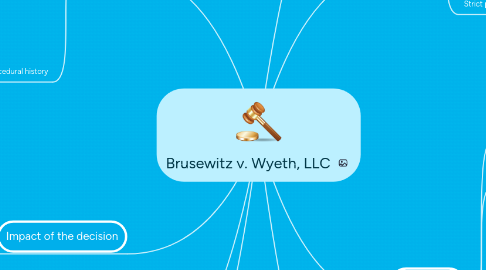
1. Facts
1.1. Parties
1.1.1. Russell and Robalee Brueswitz
1.1.1.1. Parents of Hannah Brueswitz
1.1.2. Wyeth, LLC
1.1.2.1. Subsidiary of Pfizer, Inc.
1.2. What happened
1.2.1. Hannah Bruesewitz received DTP vaccine
1.2.1.1. Age 6 months
1.2.1.2. Followed CDC immunization schedule
1.2.2. Child begin to develop seizures two hours after the vaccination
1.2.2.1. More than 100 seizures the next month
1.2.2.2. Hospitalized for weeks
1.2.2.3. Diagnosed with residual seizure disorder and developmental delay
1.2.2.4. Child will require lifelong medical care
1.2.3. DTP vaccine was manufactured by Wyeth
1.3. Procedural history
1.3.1. Plaintiff filed a claim that was denied in the US Court of Federal Claims
1.3.1.1. Filed under the National Childhood Vaccine Injury Act (NCVIA)
1.3.1.1.1. This is a no-fualt compensation program for persons injured by vaccines
1.3.2. Plaintiff then filed again Wyeth in state court in Pennsylvania
1.3.2.1. Alleged that Wyeth was liable under strict product liability
1.3.3. Suit moved to federal district court
1.3.3.1. Judgment was that claim was preempted by the NCVIA
1.3.4. US court of Appeals for the Third Circuit affirmed the district court's judgment
1.3.5. Plaintiff appealed to the US Supreme Court
2. Impact of the decision
2.1. 891 Citing references in Westlaw
2.1.1. 2 with negative treatment
2.2. Holmes v. Merck & Co., Inc.
2.2.1. Parents of deceased child due to vaccination sued Merck
2.2.1.1. NCVIA preempted all state law product liability claims
2.2.1.2. Brusewitz v Wyeth was cited
2.2.1.2.1. Stare decisis
2.3. Milik v. Secretary of Health and Human Services
2.3.1. Parents petitioned for compensation under NCVIA for child's neurological condition
2.3.1.1. NCVIA was the avenue for compensation as opposed to civil tort
2.3.2. Courts determined that child's conditions was not caused by vaccination
3. Affected business practices
3.1. Vaccine market is stabilized with vaccine manufacturers continuing to make vaccines
3.2. Vaccine victims musth go through NCVIA instead of civil tort
3.3. Other industries may try to pass similar legislation for their protection
4. Business operations
4.1. Business professionals need to be intimately knowledgable of strict product liability
4.2. Business professionals need to be aware of any legislations that preempts against civil tort
5. Issue
5.1. Does the NCVIA shield vaccine manufacturers from any product liability?
6. Rule
6.1. National Childhood Vaccine Injury Act
6.1.1. Protects vaccine manufacturers against civil suits for "unavoidable" injuries
6.1.2. Vaccine must be properly prepared and labeled
6.1.3. Preempts against any claims against vaccine manufacturers
6.2. Strict product liability
6.2.1. Product in defective condition
6.2.2. Defendant must normally be engaged in business of selling or distributing product
6.2.3. Product is unreasonably dangerous due to the defective condition
6.2.4. Plaintiff incurs physical harm
6.2.5. Defective condition must be proximate cause of injury
6.2.6. Product not substantially changed from being sold to time of injury
7. Application
7.1. Plaintiff argues that Wyeth is liable under strict product liability
7.1.1. Injuries were a direct consequence of a defective product
7.2. Wyeth argues that they are shielded by the NCVIA
7.2.1. Civil tort is NOT an option
7.2.2. Plaintiff argues that NCVIA does not protect against all design-defect claims
7.3. Congress enacted the NCVIA in order to stabilize the vaccine market
7.3.1. Prior to NCVIA, there was a huge surge of vaccine-related tort litigation
7.3.2. The vaccine market was destabilized
7.3.2.1. Vaccine manufacturers felt that the liability of the vaccines was not financially worth it
7.3.2.2. Two of the three domestic manufacturers withdrew from the market
7.3.2.3. Public health was at risk
7.4. Purpose of the NCVIA is two-fold
7.4.1. Compensate vaccine victims in a fair and timely manner
7.4.2. Reduce the costly burden of litigation on vaccine manufacturers
7.5. Quid pro quo
7.5.1. Stabilization of the vaccine market and the good of public health
7.5.2. In return for tort-liabiity protection for vaccine manufacturers
